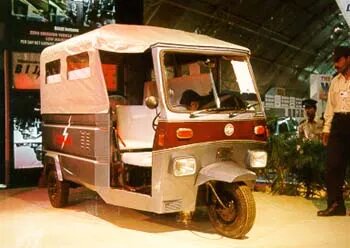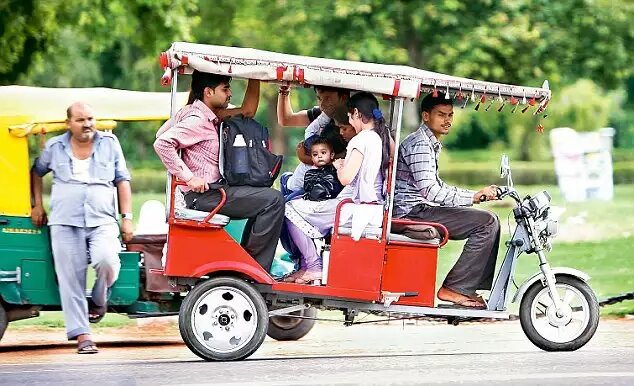
If we are to witness a massive EV revolution anywhere in the country then we can take into account the Electric three-wheeler that is being adopted by people everywhere. Be it a small-pocket person tired of pulling the rickshaw loads or a middle-class person who sees an opportunity of setting up a new mobility business e-rickshaws are ubiquitous. According to NITI Aayog’s report, in India, the three-wheeler EV market accounts for 79% of all EVs. Currently, this sector is propelling India’s car industry’s electrification.
The Indian electric rickshaw market was estimated to be worth USD 1.1 billion in 2021; by 2027, it is anticipated to have grown to USD 2.8 billion, exhibiting a CAGR of more than 11%. (2022 – 2027).
However, the sector has to face a lot of downs due to massive curfew-like conditions in COVID-infection hotspots and as a result of lockdowns. The COVID-19 pandemic has had an adverse effect on the expansion of the Indian electric rickshaw sector. The virus’s effect led to a reduction in the demand for shared electric mobility services. Thus, deterring mobility service providers from investing in e-rickshaws.
The Indian government is currently encouraging electric vehicles in fleets and public transportation, with a focus on two- and three-wheelers, cabs, and buses. By implementing FAME II policies around the Indian market. Due to this, the market is anticipated to expand steadily.
There is a global demand for e-rickshaws because of their low cost of transportation, reasonable affordability, and ability to maneuver through crowded metropolitan roadways. They are also gaining popularity among businessmen as they provide the option of last-mile delivery at minimal cost which helps in backing a lot of profit.
Furthermore, e-rickshaws are becoming more popular with consumers thanks to stricter emission regulations, higher fuel costs, incentives, and a wider selection of e-rickshaws.
Due to the rising demand for these rickshaws in Tier-1, Tier-2, and the rural-urban markets. Uttar Pradesh can the India’s largest e-rickshaw market during the forecast period.
Table of Contents
History
In order to improve the quality of manual rickshaws, the development of the e-rickshaw began in India in the late 1990s. Nimhkar Agricultural Research Institute used the motor assisted pedal rickshaw (MAPRA) to create the e-rickshaw called NARI. Later, ELECSHA (electric rickshaw) 2000 was also developed, but due to problems with battery performance and quality, they could not become popular in the market.

Then, Mahindra introduced its first electric three-wheeler in 1999. E-rickshaws started to acquire popularity in various metropolitan and semi-urban districts of UP, Bihar, West Bengal, and some other cities around 2010. The number of e-rickshaws in Delhi NCR increased during the Commonwealth Games. In Delhi, e-rickshaws were introduced with the intention of eventually replacing traditional cycle rickshaws.

E-rickshaws were later removed from the NMT category and included as a last-mile connection modal alternative by the 2014 Motor Vehicles Act, changing the original goal.
E-rickshaws used to be imported in the beginning, but they are now produced domestically. Advanced Lithium-ion batteries are also produced in large quantities, and the ecosystem supporting e-rickshaws is expanding quickly.
Deployment of E-rickshaws and Approaches
To prepare for the deployment of e-rickshaws, the local administration must implement a series of short-, medium-, and long-term action plans.
A methodology is needed to carry out the project of deploying e-rickshaws. Depending on the city’s size, route, population, infrastructure, problems, and demand, the city may decide to follow a certain strategy. Cities may find an efficient way to comprehend the project and make use of the deployment results. The local authority has two options for deployment in the city after the results are analysed. The two methods are the Big Bang and the Phased Transition Approach.
How are E-Rickshaws proving beneficial?
According to the India Energy Outlook 2021 study by the International Energy Agency, there are currently five two- and three-wheelers for every passenger automobile. For India, these asymmetries might be significant. Electric scooters, motorbikes, small cargo carriers, and rickshaws have mostly been responsible for the electrification of road transportation in the nation up until this point. “The number of electrified two‐ and three‐wheelers has grown by more than 60% each year on average since 2015, and there were 1.8 million such vehicles in 2019,” listed by International Energy Agency. Since only 3% of two- and three-wheeler sales in 2019 were electric cars, there is still a tonne of space for growth despite this quick adoption.
In addition to other vehicles, E-rickshaws would be a wise alternative for last-mile connection. They are regarded as smart because they are suited for urban settings, emit little local pollution, have low emissions, and have fast speeds. There are some problems with e-rickshaws that might be related to various smart characteristics, however, these problems could be resolved with advancements
According to a report by the NITI Aayog and the think tank RMI India, the annual credit market for EVs is anticipated to increase to Rs 3.7 lakh crore by 2030 in terms of raising finance for this transformation. Two- and three-wheelers will make up little under 10% of this, but they will be disproportionately important in terms of creating worthwhile jobs and assisting subnational governments in achieving important climate-related objectives like lowering air pollution.
Benefits of E-rickshaws mentioned by Niti Aayog
- In addition to being a means of mobility, three-wheelers provide a lifeline for many individuals who utilize them for formal or informal employment.

- The value proposition offered by the 3W EV is superior in the shared mobility market services like OLA, Uber, etc. A journey in e-rickshaw costs as little as Rs. 10. This draws passengers’ attention to the e-rickshaws.
- With the expansion of shared transportation via rail, metro, buses, etc., there is an increasing need for last-mile connectivity. E-rickshaws often fill the gap between supply and demand for last-mile connectivity in outlying areas and locations that are remote from metropolitan connectivity networks. Government agencies are collaborating with businesses like Kinetic Green and SmartE to offer their e-rickshaws for the last mile of connectivity from metro stations.
- When compared to an ICE vehicle, the cost of maintenance for a 3W EV is roughly 80% lower.
- Driving on a familiar, shorter route means there is no range of anxiety problems, which are a problem for other types of electric vehicles.
- Compared to a regular auto rickshaw, e-rickshaws are cleaner, quieter, and more affordable to maintain. In comparison to cycle rickshaws, which need manual peddling, they are also less taxing.
Read More: E-Rickshaw Battery Market Size and Top Companies
Promotion policies adopted by the GOI for promoting e-rickshaws
National Electric Mobility Mission (NEMMP), 2020
This mission is an extension of the 2013 initiative which focused on enhancing the manufacturing and usage of electric 3W. The goal of this initiative was to promote hybrid and electric vehicles along with reducing fuel imports. The initiative focused on an electric two-wheeler, three-wheeler, and four-wheeler respectively. It aims on putting 5-6 million electric vehicles on the road by 2020.
Not just this, but different state-level initiatives have also been taken by different state governments to improve e-mobility.
Proper monitoring of e-rickshaws has to be done in addition to giving a subsidy along with that we need a large charging infrastructure for the massive adoption of electric vehicles.
Initiatives
Rapid e-rickshaw growth is thought to be a contributing factor to escalating traffic congestion and an increase in accidents. Given the escalating problems with e-rickshaws, the government started working on a regulatory framework to oversee e-rickshaw operations in 2013. These new policies and initiatives are being implemented at the local, state, and federal levels.
Initiatives and policies related to e-rickshaws that have been developed at the national level cover a variety of topics, including the requirement that manufacturers adhere to safety standards, financial support in the form of loans or subsidies, information on licensing, and other supporting reforms.
Following national initiatives in the EV industry, governments realised in 2014 that they needed to create a state-level regulatory framework for e-rickshaws. State governments have also increased their involvement in creating policies.
A lower GST rate for electric vehicles, chargers, and charging stations has also been declared by the Indian government.
Challenges
In the beginning, lack of adequate charging infrastructure and range anxiety were the biggest problems for e-rickshaws. However, due to the quick growth, it is now getting easier to develop shared and public electric transportation in India.
The dependence on imports brought on by a lack of manufacturing and production, the high cost of purchasing electric bus fleets, a lack of research and development into batteries and EVs, a lack of infrastructure for charging, a lack of battery disposal systems, and outdated diesel vehicle scrapping regulations are a few of the challenges that lie ahead.
Conclusion
Compared to other types of motorized public road transport vehicles in the state, e-rickshaws are more energy-efficient.
The proper use of e-rickshaws has the ability to alleviate the problems with environmental pollution brought on by transportation since the E-rickshaws specific CO emission was found to be 19.129 gm/passenger-km.
However, in order to execute these e-rickshaws effectively, the major issues must be resolved. E-rickshaws have the potential to reduce the amount of gasoline used for passenger transportation, which might have positive effects on the environment and the economy.
To be compatible with modern traffic, the electric rickshaw’s technology needs to be improved. Vehicle design demands upholding passenger safety requirements, necessitating thorough examination of these vehicles by the appropriate authorities. To eliminate vehicle conflicts, the number of these e-rickshaws operating in various locations needs to be properly regularised.
Read More: Electric Three-Wheeler Manufacturers In India | E-rickshaws







